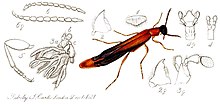The Lymexylidae (historically often spelled Lymexylonidae), also known as ship-timber beetles, are a familyofwood-boring beetles. Lymexylidae belong to the suborder Polyphaga and are the sole member of the superfamily Lymexyloidea.
| Ship-timber beetles
| |
|---|---|

| |
| Lymexylon navale | |
| Scientific classification | |
| Domain: | Eukaryota |
| Kingdom: | Animalia |
| Phylum: | Arthropoda |
| Class: | Insecta |
| Order: | Coleoptera |
| Suborder: | Polyphaga |
| Infraorder: | Cucujiformia |
| Superfamily: | Lymexyloidea |
| Family: | Lymexylidae Fleming, 1821 |

Lymexylon, Elateroides, and Melittomma are pests to forest trees such as chestnut, poplar, and oak, and can be found worldwide. Some species are parasitic, causing decay in living trees and damaging timber structures such as houses and ships. Wood boring activities occur primarily in the larva stage, with the larvae damaging both sapwood and heartwood. Lymexylidae larvae bore into living and decaying wood where they consume the fungus Alloascoidea hylecoeti.[1][2]
Lymexylidae larvae have a symbiotic association with certain types of fungi. The fungi grow in sheltered environments where they are tended by the larvae, such as the holes burrowed into the wood and, in return, the larvae feed on the fungi.[3]
Specifically, this species has evolved a relationship with the yeast-like fungus Endomyces hylecoeti. Every egg the female lays is coated with fungal spores from a pouch near her ovipositor. The larvae hatch and subsequently collect some of the spores by remaining close to the egg shells for a period of time, before tunneling further into the wood. The fungi grow on the tunnel walls created by the larvae. The larvae then consume the fungus, rather than the wood itself. As the fungi require air flow to grow, the larvae ensure the tunnels are free of any debris.[4]
Lymexylidae contain the following genera:[5]
There are over 60 species in these genera, including:
Adult morphology:
Immature Morphology:
The superfamily Lymexyloidea is currently within series Cucujoidea. The internal phylogeny has not been clearly understood/completed by experts. Morphological data places the family inside the Tenebrionoidea, while molecular data place it as sister taxon to Tenebrionoidea, and polyphyletic.